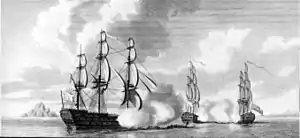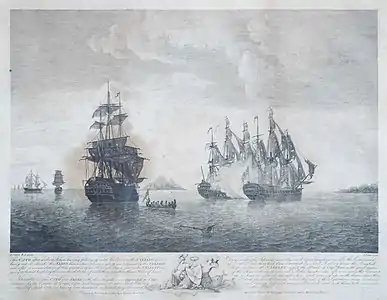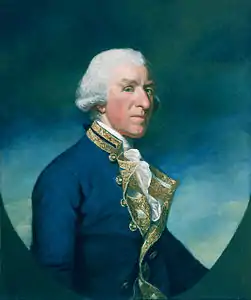| Battle of the Mona Passage | |||||||
|---|---|---|---|---|---|---|---|
| Part of American Revolutionary War[1] | |||||||
 The capture of the French 64-gun ships Caton and Jason by the Valiant in the Mona Passage, 19 April 1782 | |||||||
| |||||||
| Belligerents | |||||||
|
|
| ||||||
| Commanders and leaders | |||||||
|
|
| ||||||
| Strength | |||||||
|
10 ships of the line 1 frigate 1 fire ship |
2 ships of the line 2 frigates 1 corvette | ||||||
| Casualties and losses | |||||||
|
10 killed 14 wounded[2] |
2 ships of the line captured 1 frigate captured 1 corvette captured 1,300 captured[3] | ||||||
The Battle of the Mona Passage was a naval engagement on 19 April 1782 taking place in the aftermath of the Battle of the Saintes between Britain and France during the American Revolutionary War.[4][5] A British fleet under Rear-Admiral Sir Samuel Hood, pursued a small French fleet under Georges-François de Framond which had managed to escape the victorious British fleet a week earlier. The two fleets met and engaged at the Mona Passage where the British overtook and captured four French ships, two of which were 64-gun ships of the line.[6]
Events
Background
Between 9 April 1782 and 12 April 1782 a British fleet under Admiral George Brydges Rodney engaged and defeated a French fleet under the Comte de Grasse at the battle of the Saintes, thus frustrating French plans for an invasion of Jamaica.[7] The British fleet made its way to Jamaica, from where Rodney ordered Rear-Admiral Sir Samuel Hood's division to seek out any disabled or damaged French ships that had escaped the battle. On 17 April Hood's division of ten ships set out toward Saint-Domingue.[8]
Battle
Both of these ships were in the Mona Passage, the strait separating Hispaniola and Puerto Rico and were making sail for Cap-Français along with several smaller ships, when Hood's squadron spotted the French.[5] These were under the command of Georges-François de Framond and the ships were in a poor state; the French 64-gun ship of the line Caton under Georges-François de Framond[9] had been damaged in the initial encounter at the battle of the Saintes on 9 April, and the Jason, also 64 guns, had been damaged the following day when it collided with the heavily-damaged Zélé. Hood chased down the French ships, the faster copper-sheathed British ships outpacing the damaged French ships. HMS Valiant captured both Jason and Caton at the cost of four men killed and six wounded, whilst HMS Magnificent captured the frigate Aimable[Note 1][10] at the cost of four killed and eight wounded.[11] Champion captured the frigate Astrée, but the latter managed to escape with minimal damage.[6]
Aftermath
Following this victory Hood rendezvoused with Rodney at Port Royal on 29 April. As a result of the damage the fleet had sustained in both battles, repairs took nine weeks.[12]
The captured French ships were taken back to England for further use. Jason was renamed HMS Argonaut, while Caton was used as a prisoner of war hospital ship and moored off Saltash in Cornwall. She continued in this role well into the Napoleonic Wars.[13] Aimable was renamed HMS Aimable and served in the Royal Navy until 1811.[14] Cérès, a former British sloop by the same name, became HMS Raven; the French recaptured her in January 1783 and sold her in 1791. Framond was court-martialed on 27 February 1783 and found guilty and was expelled from the Navy.[15]
 Sketch of the action by Dominic Serres
Sketch of the action by Dominic Serres
 The capture of the 32-gun French frigate Amiable and the corvette Ceres after their encounter with Sir Samuel Hood in the Barfleur, with the Valiant and the Magnificent, in the Mona Passage, 19 April 1782
The capture of the 32-gun French frigate Amiable and the corvette Ceres after their encounter with Sir Samuel Hood in the Barfleur, with the Valiant and the Magnificent, in the Mona Passage, 19 April 1782
Order of battle
BritainBarfleur (98) - Flagship of Sir Samuel Hood, Capt. John Knight |
FranceCaton (64) - Capt. de Framond - Captured |
References
- Notes
- ↑ Aimable had been launched on 20 July 1776
- Citations
- ↑ Tucker 2013, pp. 373–75.
- ↑ Allen, Joseph (1852). Battles of the British Navy'. London: Henry Bohn. p. 343.
- ↑ Southey, Thomas (1827). Chronological History of the West Indies by Captain Thomas Southey. In Three Volumes: 2. Longman, Rees, Orme, Brown & Green. p. 533.
- ↑ Winfield 2007, p. 111.
- 1 2 Harvey 2004, p. 530.
- 1 2 Allen 1852, p. 343.
- ↑ Eggenberger 1985, p. 376.
- ↑ Mahan 2013, p. 224.
- ↑ Contenson, Ludovic (1934). La Société des Cincinnati de France et la guerre d'Amérique (1778-1783). Paris: éditions Auguste Picard. p. 180. OCLC 7842336.
- ↑ Demerliac 1996, p. 68.
- ↑ Southey 1827, p. 533.
- ↑ Fraser, Edward (1904). Famous Fighters of the Fleet: Glimpses Through the Cannon Smoke in the Days of the Old Navy. Kessinger Publishing.
- ↑ Moseley, Brian (May 2011). "Prison Ships". The Encyclopaedia of Plymouth History. Plymouth Data. Archived from the original on 28 September 2013. Retrieved 15 February 2015.
- ↑ Ships of the Old Navy: HMS Aimable
- ↑ Contenson 1934, p. 180.
Bibliography
- Demerliac, Alain (1996). La Marine de Louis XVI : Nomenclature des navires français de 1774 à 1792. Omega. ISBN 9782906381230.
- Desmarais, Norman (2019). America's First Ally: France in the Revolutionary War. Casemate. ISBN 9781612007021.
- Eggenberger, David (1985). An Encyclopedia of Battles: Accounts of Over 1,560 Battles from 1479 B.C. to the Present. Courier Corporation. ISBN 9780486249131.
- Harvey, Robert (2004). A Few Bloody Noses: The American Revolutionary War. Robinson. ISBN 9781841199528.
- Mahan, Alfred Thayer (2013). The Major Operations of the Navies in the War of American Independence. Courier Dover Publications. ISBN 9780486842103.
- Stoker, Donald; Hagan, Kenneth J.; McMaster, Michael T. (2009). Strategy in the American War of Independence: A Global Approach. London; New York; Routledge. ISBN 978-1-1342-1039-8.
- Tucker, Spencer (2013). Almanac of American Military History, Volume 1. ABC-CLIO. ISBN 9781598845303.
- Winfield, Rif (2007). British Warships in the Age of Sail 1714-1792: Design, Construction, Careers and Fates. Seaforth Publishing. ISBN 9781844157006.